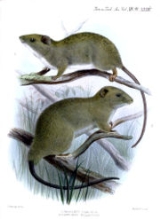
Short-footed Luzon Tree Rat
Encyclopedia
The Short-footed Luzon Tree Rat or Greater dwarf cloud rat (Carpomys melanurus) is a species of rodent
in the family Muridae
.
It is found only in the Philippines
especially in northern luzon. Its natural habitat
is subtropical or tropical moist montane
s.
This species was long thought to be extinct. In 2008, Filipino researchers including Dr. Danilo Balete found a specimen in the canopy of Mount Pulag National Park, the first scientifically observed individual of the species since 1896. The captured individual was "about 185 grams and has dense soft reddish-brown fur, a black mask around large dark eyes, small rounded ears, a broad and blunt snout and a long tail covered with dark hair".
Rodent
Rodentia is an order of mammals also known as rodents, characterised by two continuously growing incisors in the upper and lower jaws which must be kept short by gnawing....
in the family Muridae
Muridae
Muridae is the largest family of mammals. It contains over 600 species found naturally throughout Eurasia, Africa, and Australia. They have been introduced worldwide. The group includes true mice and rats, gerbils, and relatives....
.
It is found only in the Philippines
Philippines
The Philippines , officially known as the Republic of the Philippines , is a country in Southeast Asia in the western Pacific Ocean. To its north across the Luzon Strait lies Taiwan. West across the South China Sea sits Vietnam...
especially in northern luzon. Its natural habitat
Habitat
* Habitat , a place where a species lives and grows*Human habitat, a place where humans live, work or play** Space habitat, a space station intended as a permanent settlement...
is subtropical or tropical moist montane
Montane
In biogeography, montane is the highland area located below the subalpine zone. Montane regions generally have cooler temperatures and often have higher rainfall than the adjacent lowland regions, and are frequently home to distinct communities of plants and animals.The term "montane" means "of the...
s.
This species was long thought to be extinct. In 2008, Filipino researchers including Dr. Danilo Balete found a specimen in the canopy of Mount Pulag National Park, the first scientifically observed individual of the species since 1896. The captured individual was "about 185 grams and has dense soft reddish-brown fur, a black mask around large dark eyes, small rounded ears, a broad and blunt snout and a long tail covered with dark hair".

